
‘Emotional blunting’ or ‘numbing’ has been described by people taking antidepressants (Faulkner, 2016), and particularly Selective Serotonin Reuptake Inhibitors (SSRIs).
According to Sansone and Sansone (2010) it is characterised by an insidious onset, dose-dependence (with higher doses causing more symptoms) and complete resolution with discontinuation of the offending drug. They describe 2 elements to the experience:
- a behavioural syndrome of apathy and low motivation
- an emotional aspect of indifference, diminution of responsiveness and detachment.
Bolling and Kohlenberg (2004) found in a survey of 161 patients who had received SSRIs for depression, about 20% had an ‘inability to cry’ and 46% a ‘narrowed range of affect’. A cross-sectional study by Fava and colleagues (2006) reported some form of ‘apathy’ in about 30% of patients on SSRIs. However there have been no large-scale epidemiological studies of this phenomenon.

Previous research has highlighted emotional blunting in people taking antidepressants, but there have been no large-scale epidemiological studies of this phenomenon.
Methods
The authors of this recent study (Goodwin et al, 2017) had previously developed a scale: the Oxford Questionnaire on the Emotional Side-Effects of Antidepressants (OQuESA) (Price et al, 2009). This was an internet-based survey in which 669 depressed patients on treatment and 150 recovered (formerly depressed) controls (aged ≥18 years) participated.
The survey was carried out by the Vision Critical organization, based in Paris, utilising 3 national panels of English speakers over 18 years old in Canada (n=98,000), the USA (n=66,000) and the UK (n=40,000). The questionnaire had 2 parts: the first to screen the targets (depressed patients with emotional blunting and recovered non-treated controls) and the second to explore emotional blunting. It took about 20 minutes to complete. Invitations to participate were sent to 7,966 (4,194 in Canada, 2,255 in the US and 1,517 in the UK) individuals identified as having depression in an initial screening (March 2010). The survey was performed between 10 September and 8 October 2010.
Subjects who had a probably lifetime diagnosis of depression were identified by a single question: whether a medical professional had given them diagnosis of depression.
Among this population, a group of depressed patients were defined who had been receiving antidepressant treatment for at least 2 months (and were still on treatment during the survey) and were either in remission or mildly depressed as assessed by a HAD depression sub-scale score ≤ 12.
Controls had a lifetime diagnosis of depression for which they had received antidepressant treatment, but they had stopped taking antidepressants at least 2 months previously and were in remission (HAD-D ≤ 7). Patients or controls receiving additional psychotropic medications (antipsychotics, mood stabilisers or antiepileptics) were excluded from the survey.
The treated participants with depression were asked a single standardised screening question: “To what extent have you been experiencing emotional effects of your antidepressant?”. The question was qualified by the explanation: “emotional effects vary, but may include, for example, feeling emotionally “numbed” or “blunted” in some way; lacking positive emotions or negative emotions; feeling detached from the world around you; or “just not caring” about things that you used to care about.” Patients who replied “mildly,” “moderately,” or “severely” were asked to complete the full questionnaire which comprised three sections:
- Exploring the current experience of emotional blunting;
- Relating the current experience of emotional blunting with the patient’s recollection of their normal emotional state prior to their depression;
- The patient’s perception of a link between the antidepressant treatment and the experience of emotional blunting, and whether this has affected compliance with treatment or induced plans to discontinue.
Each item was rated on a 5-point scale ranging from disagree to agree.
The recovered controls completed only the first two sections.
Results
The sample included 854 patients on antidepressants and 150 recovered controls. In the sample on antidepressants, 401 reported significant emotional blunting, of whom 91 were receiving more than one antidepressant. The latter were excluded to provide a more homogeneous population of depressed patients on monotherapy, for whom the rate of emotional blunting was 46% (310/669); 53% (453/854) reported no emotional blunting on the screening question.
The experience of emotional blunting was slightly more frequent in men than women (52% versus 44%) and in those with higher Hospital Anxiety and Depression (HAD) scale scores. Depressed patients with emotional blunting had much higher total blunting scores on OQuESA than controls (42.83±14.73 versus 25.73±15.00, p<0.0001) and there was a correlation between total blunting score and HAD-Depression score (r =0.521). Thus, those with HAD-D score >7 (n=170) had a higher total questionnaire score, 49.23±12.03, than those with HAD-D score ≤7 (n=140) 35.07±13.98, and the difference between the two groups was highly significant. However, patients with HAD-D score ≤7 (n=140) had a higher total score (35.07±13.98) than the recovered controls (n=150) (25.73±15.00), and the difference between the two groups was significant.
Among the patients with emotional blunting, 37% had a negative perception of their condition and 38% positive. Men reported a more negative perception than women (p=0.008), and patients with a negative perception were more likely to have higher HAD scores. Higher levels of emotional blunting were associated with a more negative perception of it by the patient (r =– 0.423).

This survey suggests that emotional blunting is reported by nearly half of depressed patients on antidepressants.
Conclusions
The authors conclude from this survey that emotional blunting is reported by nearly half of depressed patients on antidepressants and that it appears to be common to all monoaminergic antidepressants not only SSRIs. Additionally they note:
The OQuESA scores are highly correlated with the HAD depression score; emotional blunting cannot be described simply as a side-effect of antidepressant, but also as a symptom of depression.
A higher degree of emotional blunting is associated with a poorer quality of remission.
Strengths and limitations
- This study has a larger sample size than previous research into this phenomenon and the OQuESA was developed from a previous qualitative study.
However:
- It was conducted by a market research organisation, and the protocol wasn’t formally approved by an ethics committee
- The presence of depression was a self-evaluation with no clinical assessment
- An internet based survey is likely to be biased to a younger population with poor representation of older people.
And I would add
- It did not explore the relationship with antidepressant dosage
- It was funded by a pharmaceutical company (Servier) and two of its authors are employees of that company.

Limitations of this evidence include the self-evaluation of depression and the modest size of the sample for detecting differences between antidepressants.
Summary
Emotion blunting may be experienced as both a helpful and unhelpful phenomenon. At a low level it may help a person to detach from their immediate problems, but at a higher level it can be very disabling.
This study suggests that emotional blunting is experienced across different antidepressants; not only SSRIs, and that one possible cause of this may be persistent depressed mood. These findings however must be weighed against the limitations of this study. In particular this was funded and partly authored by a company that was marketing a novel antidepressant (Agomelatine: not widely available at the time of the survey) in competition with traditional SSRIs. There was no exploration of the previously observed association with dosage and numbers were too small to reliably make any comparison between drugs.
An assumption that emotional blunting is caused by persistent depression seems premature. Indeed the authors note this as only one possible cause of the phenomenon.

We can’t be sure from this evidence whether emotional blunting is being caused by the antidepressants, the depression itself, or something else entirely.
Links
Primary paper
Goodwin GM, Price J, De Bodinat C, Laredo J. (2017) Emotional blunting with antidepressant treatments: a survey among depressed patients. Journal of Affective Disorders http://dx.doi.org/10.1016/j.jad.2017.05.048
Other references
Bolling MY, Kohlenberg RJ (2004) Reasons for quitting serotonin reuptake inhibitor therapy: paradoxical psychological side effects and patient satisfaction. Psychotherapy and Psychosomatics 73: 380-385.
Fava M, Graves LM, Benazzi F, Scalia MJ et al (2006) A cross-sectional study of the prevalence of cognitive and physical symptoms during long-term antidepressant treatment. Journal of Clinical Psychiatry 67: 1754-1759.
Faulkner A People’s experience of taking antidepressants The Mental Elf 8 July 2016
Price J, Cole V, Goodwin GM (2009) Emotional side effects of selective serotonin reuptake inhibitors: qualitative study. British Journal of Psychiatry 195: 211-217
Sansone RA, Sansone LA (2010) SSRI-Induced Indifference. Psychiatry (Edgmont ) 7: 14-18.
Photo credits
- Photo by Joshua K. Jackson on Unsplash
- Photo by Alex Iby on Unsplash
- Photo by ariel sion on Unsplash
- Photo by Aliis Sinisalu on Unsplash
- Photo by Ken Treloar on Unsplash

How is emotional ‘blunting’ different from anhedonia, one of the core symptoms of depression. In a qualitative study with teenagers, not on anti-depressants as a rule, many describe feeling ‘nothihg’, ‘like everything is grey’, ‘flat’, ‘empty’….we have seen this as an aspect of anhedonia and in these young people it isn’t a side effect of medication as they are not on meds.
I have known and worked with (still am on one project) Linda for about 40 years (sorry Linda) and share her views and dont share those of David Healy. I became depressed working for Swansea University…karma has eventually got to the bullies (not all of them yet) and I have just stopped after 12 years my maintenance dose of Citalopram. I never had depression as severe as Linda so I am not arguing against antispressants in the short or long term. After the ‘debate’, between Linda and David on breakfast tv I texted to say what many people including the guy in the video want to know is how to stop taking them.i did stop for 3 months in the past and a life event prompted me to start again. Then, and now, I have the same experience and I conclude that you can’t entirely tell what they are doing to you until you stop. So, in short, I now have vivid dreams again (ok by me) my libido has gone up , back to when I was 50 {hi SK} , vision is like AR, energy levels increasing, flat affect is going (moist eyes at the Repair shop and almost certainly at the next Strictly) so mood is appropriate ((no anhedonia) weight loss, optimism in the face of Bojo, need I go on. Just wanted to share this ; done without medical supervision, but I have a great GP and she will understand. Did try titration but then I was having such a good time I just stopped, nearly a month now, and if I’m wrong i’ll come back and confess????